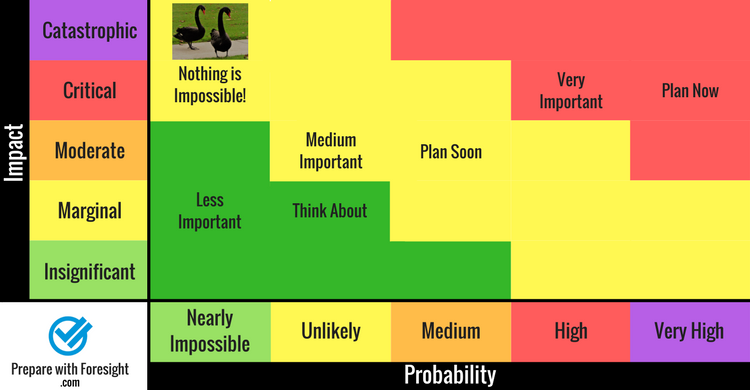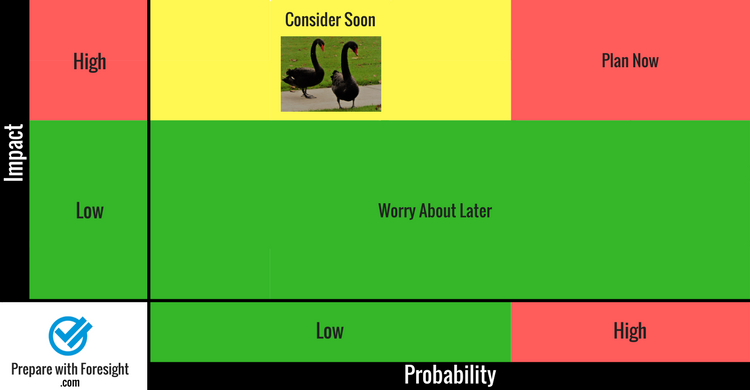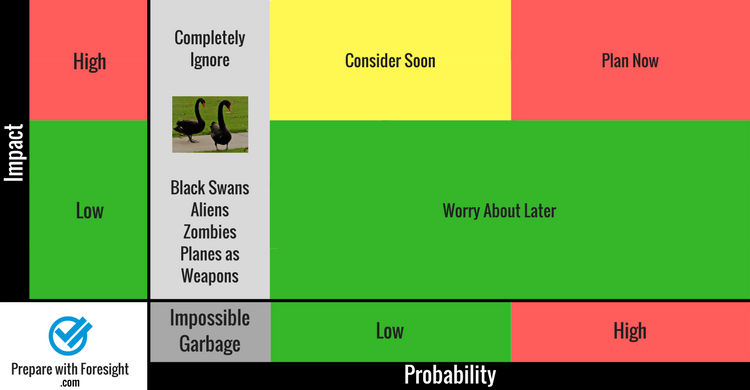Not everyone remembers where they were when the stock market crashed or when Trump was elected the US President. However, many people around the world remember where they were and how they felt when the attacks happened on September 11, 2001. My two previous posts have introduced strategic foresight and how some of its tools and methods can help you better prepare for the unexpected. Now, let’s dig a little deeper and look at different types of scenarios such as Black Swans.
What is a Black Swan?
The 9/11 attacks seemed so random that they shocked the world. For many people, even non-Americans, the world felt upside down in the days that followed. However, terrorism was already an imminent threat, and terrorists had already hijacked planes. They had even committed suicide and murder simultaneously (suicide bombers) before 9/11, and they had already attacked the World Trade Centre.
All the weak signals look so obvious in hindsight. Before 2001, however, the idea of such a large and significant attack on US soil—much less the use of commercial jets as weapons—seemed ludicrous to most people. Anyone over the age of 30 will still remember the shock despite the flood of articles just like the one I’m writing. 9/11 is one of the best-known examples of a Black Swan event.
Black Swans are events that appears highly implausible, if not impossible, before it happens. But when it does happen it has a significant impact on the population. So, it has a low probability but a high impact. After such an event occurs, many people rationalize that it should have been obvious, even predictable.
Why wasn’t 9/11 predictable?
Every day, we wake up to assumptions we hold about the world around us. We assume the sun will rise. We assume most people are good people, but we also assume traffic will be infuriating. We assume certain things about our jobs, our families, and our own behavior, even when we know better. We assume today will be much like yesterday.
Similar assumptions were made the morning of September 11, 2001. Those paying attention to the weak signals mentioned above, recognized the trends. Some, such as a Cornish man named Rick Rescorla, even prepared for disaster. Their foresight is documented, but it did nothing to prevent the disaster.
The people with the foresight to recognize the coming tragedy were capable of scenario thinking. The people with the power to prevent, circumvent, or even mitigate the attacks were stuck in a mindset of business as usual. “It can happen, but it won’t happen today,” is what they thought. Their view of the future was too limited. They saw the future in only three boxes:
Black Swans as shown in the above figure has a very low probability (nearly impossible) but a high impact. This figure is based on a very common risk matrix. It allows for only two types of probability, high and low. And it allows for only two types of impact, high and low.
Black Swans should appear in the Consider Soon box, but before 9/11, very few people bothered to consider the things they thought as impossible. So, they had a fourth box for anything that they considered ludicrous such as alien invasion, grey goo, medical zombie pandemic, or high fatality terrorist attacks on US civilian locations. Their view of the future really looked like this:
Having learned a hard lesson, many people in power have taken the seemingly impossible a little more seriously since 9/11. Planners can’t afford to take anything for granted anymore. Consider nothing as impossible!
How should we view the future?
As simple as the matrix above is, it is not very useful for thinking about the future. It is too basic. An event requiring your survival tactics can come in any form. Why would you only prepare for three types of scenarios? So, let’s allow ourselves to think about the future more broadly. Think of the future as a complex system just like a supercomputer, the weather, the human body, traffic, or a marriage.
The visual below should start to give you an idea of how complicated preparing for the future should be. The complexity will come later as we consider multiple scenario types happening within a 5-year period.

You’ll notice the boxes are shaded red, yellow, and green. Clearly, you should be planning for the red as soon as possible since the impact and probability are both high. Scenarios in the yellow need to be prepared for immediately after the red. If a scenario’s impact is significant, plan for it regardless of its probability. Also, plan for scenarios with minor impact if their probability is high. The green should never be ignored! A minor event can lead to more serious changes.
Not just theoretical, consider your own Black Swans
Stop for a moment, and think about where on the above table you would place the following scenarios:
- Global pandemic
- Your car wrecked
- Prolonged power outage
- Guinness goes bankrupt
- Your job/income lost
- Stock market crash
- Your arm broken
- Nuclear terrorist attack
- Riots in your city
- Political revolution in your country
- J. J. Abrams remakes Mad Max starring Daniel Radcliffe (clearly catastrophic!)
- Deadly epidemic in your region
- Your neighbour sues you
All of the above and more
Any of the proposed scenarios above are entirely plausible in the next five years. In fact, all of them could happen within the next five years. Again, 9/11 appeared to be impossible to many if not most people before it happened.
There have been terrorist attacks in the US before and since 9/11. What made 9/11 so shocking? What made this event the best example of a Black Swan since the millennium? More importantly, what would shock the world now? What would shock you? What could the next Black Swan look like and what are the weak signals?
It’s also possible that nothing so shocking will happen on a global stage for another 100 years. That’s why we need to plan for a variety of scenario types and a variety of scenarios within those types. We can’t predict the future, but we can prepare for it.
How do we prepare for it?
It’s a futurist cliché, and it is entirely true: We overestimate what can happen in the short term and underestimate what can happen in the long term.
Preparing for the future is about habitually accepting change and optimizing your response with each new change. It is about anticipating changes, questioning your assumptions about the world, and recognizing what influence you can have on those changes.
Also See: Strategic Foresight for Disaster Preparedness
But before all of that, you need to understand your assumptions about the world currently, and how those assumptions might be wrong. Then you need to understand how you currently estimate the kind of change that can happen in any given period of time (5 minutes, 5 days, 5 months, 5 years, 5 decades). Once you accept that your view of the future is too small and too limited, you can begin to learn how to improve it. We’ll cover that in the next article.

Dennis Draeger is the research director for Shaping Tomorrow, https://shapingtomorrow.com/. He has over 15 years’ experience in business start-up, management and consulting. He has helped clients around the world think more effectively about the future. To see some of his other work, visit Aiglatson Foresight Research, https://aiglatsonforesight.com/.



